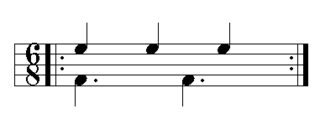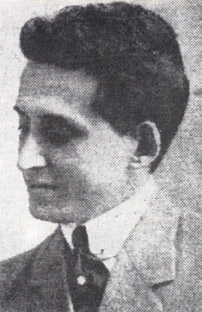Mambo is a genre of Cuban dance music pioneered by the charanga Arcaño y sus Maravillas in the late 1930s and later popularized in the big band style by Pérez Prado. It originated as a syncopated form of the danzón, known as danzón-mambo, with a final, improvised section, which incorporated the guajeos typical of son cubano. These guajeos became the essence of the genre when it was played by big bands, which did not perform the traditional sections of the danzón and instead leaned towards swing and jazz. By the late 1940s and early 1950s, mambo had become a "dance craze" in Mexico and the United States as its associated dance took over the East Coast thanks to Pérez Prado, Tito Puente, Tito Rodríguez and others. In the mid-1950s, a slower ballroom style, also derived from the danzón, cha-cha-cha, replaced mambo as the most popular dance genre in North America. Nonetheless, mambo continued to enjoy some degree of popularity into the 1960s and new derivative styles appeared, such as dengue; by the 1970s it had been largely incorporated into salsa.
The music of Cuba, including its instruments, performance, and dance, comprises a large set of unique traditions influenced mostly by west African and European music. Due to the syncretic nature of most of its genres, Cuban music is often considered one of the richest and most influential regional music in the world. For instance, the son cubano merges an adapted Spanish guitar (tres), melody, harmony, and lyrical traditions with Afro-Cuban percussion and rhythms. Almost nothing remains of the original native traditions, since the native population was exterminated in the 16th century.
Bolero is a genre of song which originated in eastern Cuba in the late 19th century as part of the trova tradition. Unrelated to the older Spanish dance of the same name, bolero is characterized by sophisticated lyrics dealing with love. It has been called the "quintessential Latin American romantic song of the twentieth century".
Guajira is a music genre derived from the punto cubano. According to some specialists, the punto cubano was known in Spain since the 18th century, where it was called "punto de La Habana", and by the second half of the 19th century it was adopted by the incipient Spanish Flamenco style, which included it within its "palos" with the name of guajira. Guajira was utilized by Spanish Zarzuela composers, such as Ruperto Chapí, who included it in his well known play "La Revoltosa", from 1897. Two years later, in 1899, the Cuban composer Jorge Anckermann inaugurated a new genre with his song "El arroyo que murmura", the first Cuban guajira. This song became a model that was adopted by many other Cuban composers at a later time, and was frequently included in the Cuban Zarzuela and vernacular theater.
Danzón is the official musical genre and dance of Cuba. It is also an active musical form in Mexico and Puerto Rico. Written in 2
4 time, the danzón is a slow, formal partner dance, requiring set footwork around syncopated beats, and incorporating elegant pauses while the couples stand listening to virtuoso instrumental passages, as characteristically played by a charanga or típica ensemble.
Son cubano is a genre of music and dance that originated in the highlands of eastern Cuba during the late 19th century. It is a syncretic genre that blends elements of Spanish and African origin. Among its fundamental Hispanic components are the vocal style, lyrical metre and the primacy of the tres, derived from the Spanish guitar. On the other hand, its characteristic clave rhythm, call and response structure and percussion section are all rooted in traditions of Bantu origin.
The guaracha is a genre of music that originated in Cuba, of rapid tempo and comic or picaresque lyrics. The word has been used in this sense at least since the late 18th and early 19th century. Guarachas were played and sung in musical theatres and in working-class dance salons. They became an integral part of bufo comic theatre in the mid-19th century. During the later 19th and the early 20th century the guaracha was a favourite musical form in the brothels of Havana. The guaracha survives today in the repertoires of some trova musicians, conjuntos and Cuban-style big bands.
Contradanza is the Spanish and Spanish-American version of the contradanse, which was an internationally popular style of music and dance in the 18th century, derived from the English country dance and adopted at the court of France. Contradanza was brought to America and there took on folkloric forms that still exist in Bolivia, Mexico, Venezuela, Colombia, Peru, Panama and Ecuador.

Criolla is a genre of Cuban music which is closely related to the music of the Cuban Coros de Clave and a genre of Cuban popular music called Clave.

Rumba is a secular genre of Cuban music involving dance, percussion, and song. It originated in the northern regions of Cuba, mainly in urban Havana and Matanzas, during the late 19th century. It is based on African music and dance traditions, namely Abakuá and yuka, as well as the Spanish-based coros de clave. According to Argeliers León, rumba is one of the major "genre complexes" of Cuban music, and the term rumba complex is now commonly used by musicologists. This complex encompasses the three traditional forms of rumba, as well as their contemporary derivatives and other minor styles.

Eduardo Sánchez de Fuentes was a Cuban composer, and an author of books on the history of Cuban folk music.
Early Cuban bands played popular music for dances and theatres during the period 1780–1930. During this period Cuban music became creolized, and its European and African origins gradually changed to become genuinely Cuban. Instrumentation and music continually developed during this period. The information listed here is in date order, and comes from whatever records survive to the present day.
Cuban musical theatre has its own distinctive style and history. From the 18th century to modern times, popular theatrical performances included music and often dance as well. Many composers and musicians had their careers launched in the theatres, and many compositions got their first airing on the stage. In addition to staging some European operas and operettas, Cuban composers gradually developed ideas which better suited their creole audience. Characters on stages began to include elements from Cuban life, and the music began to reflect a fusion between African and European contributions.

Adolfo Columbo was a leading singer in the Alhambra Theatre in Havana, and also an actor and a leading personality in the theatre. Colombo was the most recorded artist in Cuba up to 1925: records show he recorded about 350 numbers between 1906 and 1917.
Punto guajiro or punto cubano – or simply punto – is a sung genre of Cuban music, a poetic art with music. It became popular in the western and central regions of Cuba in the 17th century, and consolidated as a genre in the 18th century. It has Andalusian and Canary Islands origins, and it integrated African elements in Cuba.

Cuban culture encompasses a wide range of dance forms. The island's indigenous people performed rituals known as areíto, which included dancing, although little information is known about such ceremonies. After the colonization of Cuba by the Spanish Kingdom, European dance forms were introduced such as the French contredanse, which gave rise to the Cuban contradanza. Contradanza itself spawned a series of ballroom dances between the 19th and 20th centuries, including the danzón, mambo and cha-cha-cha. Rural dances of European origin, such as the zapateo and styles associated with punto guajiro also became established by the 19th century, and in the 20th century son became very popular. In addition, numerous dance traditions were brought by black slaves from West Africa and the Congo basin, giving rise to religious dances such as Santería, yuka and abakuá, as well as secular forms such as rumba. Many of these dance elements from European dance and religious dances were fused together to form the basis of la técnica cubana. Cuban music also contributed to the emergence of Latin dance styles in the United States, namely rhumba and salsa.
María Enma Botet Dubois was a Cuban pianist, composer and music educator. She was born in Matanzas and studied music with Hubert de Blanck and Joaquin Nin. After completing her studies, she taught music at the Hubert de Blanck Conservatory and the Amadeo Roldan Conservatory in Havana. She died in Miami.
Throughout the years, the Cuban nation has developed a wealth of musicological material created by numerous investigators and experts on this subject.
Raimunda Paula Peña Álvarez, better known as Paulina Álvarez, was a renowned Cuban singer of danzonetes. She became the leading exponent of the genre during the 1930s, being nicknamed La Emperatriz del Danzonete. Her greatest hit was the song "Rompiendo la rutina", the first danzonete, composed by Aniceto Díaz in 1929. In 1960 she recorded her only LP record.
Galician rumba belongs to those songs and dances called cantes de ida y vuelta, "of departure and return", like the Habanera, that travelled back from Cuba to the Spanish motherland to establish themselves as musical genres cultivated and cherished by the Spanish population.





